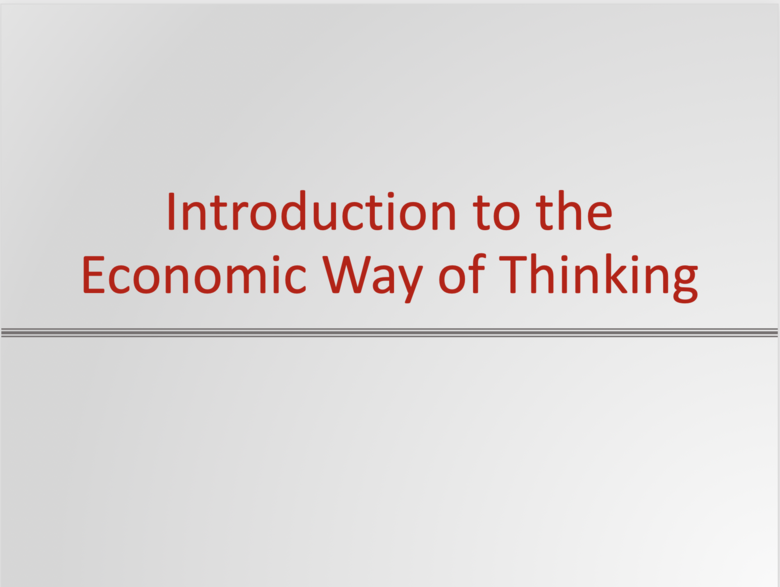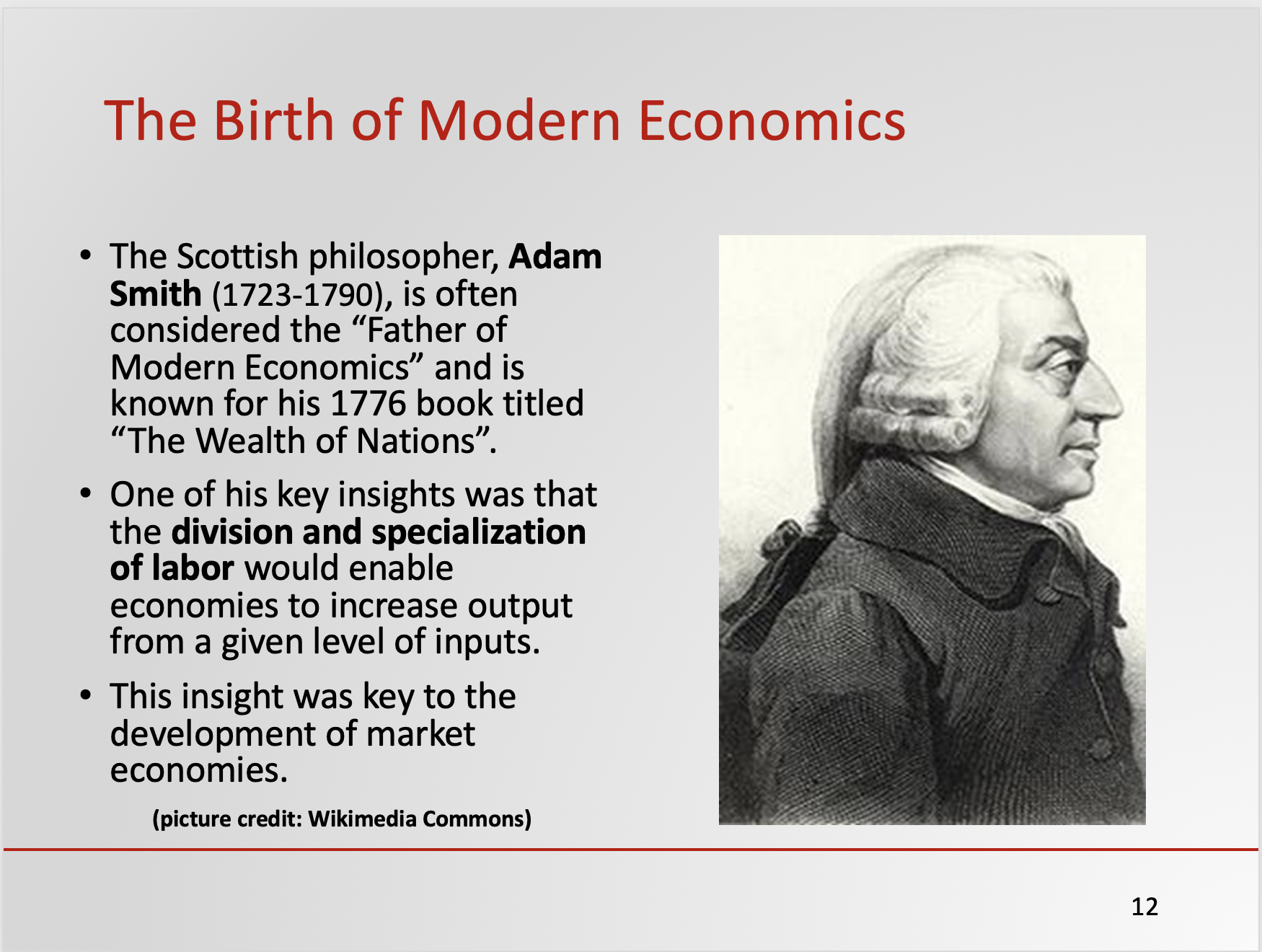Introduction to the Economic Way of Thinking Resources

Overview
In this opening topic, students will be introduced to the fundamentals of economics including some important concepts and terms that they’ll use throughout the course. They’ll begin by learning about the basic problem in economics and how that problem is solved under different economic systems, including the market system. They’ll also be introduced to the idea of an economic model.
Learning Objectives
- State and explain the basic problem of economics (1,2,3)
- Define and discuss the relationship among scarcity, choice and opportunity cost (2,3)
- Indicate the three essential questions that all economies must answer (3)
- Identify the primary types of economic organization (3, 16)
- Discuss economic models and their characteristics (1, 16)
- Discuss the circular flow model as a visualization of the economy (2,3)
- Explain key concepts in economics such as the ceteris paribus assumption and the difference between positive and normative statements (2)
NOTE: This module meets Ohio TAGs 1, 2, 3, 4 & 16 for an Intro to Microeconomics course
Recommended Textbook Resources
Principles of Microeconomics 2e: Welcome to Economics! 
Chapter 1; Sections: 1.1, 1.2, 1.3, Key Terms, Key Concepts and Critical Thinking Questions
Full Citation: Greenlaw, S. and Shapiro et al. “Welcome to Economics!” Principles of Microeconomics 2e. OpenStax CNX. June 4, 2018.
Principles in Microeconomics 2e: Choice in a World of Scarcity
Chapter 2; Sections: 2.1, 2.2, Key Terms, Key Concepts and Critical Thinking Questions
This chapter covers all learning objectives with the exception of #3. That learning objective is covered by the supplemental text.
Full Citation: Greenlaw, S. and Shapiro et al. “Choice in a World of Scarcity” Principles of Microeconomics 2e. OpenStax CNX. June 4, 2018.
Supplemental Content/Alternative Resources
Alternative Textbook Resources
Microeconomics: Markets, Methods, and Models
Chapter 1: Introduction to Key Ideas
Sections 1.1, and 1.3
Section 1.1 gives additional coverage of the definition of economics, scarcity and opportunity cost and the three fundamental questions economies must answer. Section 1.3 presents another treatment of economic models, the ceteris paribus condition and the difference between positive and normative economics. It also defines the fallacy of false cause.
Full Citation: University of Minnesota Libraries, Minneapolis, MN. “What’s it all about?
” Microeconomics: Markets, Methods, and Models, Publishing Ed. 2016. University of Minnesota, CCA, 2016.
Microeconomics: Markets, Methods, and Models
Chapter 2: Theories, Models and Data
Sections 2.5, pages 45, 46
Full Citation: University of Minnesota Libraries, Minneapolis, MN. “Ethics, efficiency and beliefs” Microeconomics: Markets, Methods, and Models, Publishing Ed. 2016. University of Minnesota, CCA, 2016.
Video Resources
The first video below provides a good (and upbeat) introduction to economics. The second provides a more detailed treatment of the circular flow model than is found in the recommended text. Both videos may be too long for classroom use but may be assigned for out of class viewing.
Introduction to Economics: Crash Course Economics #1
This video provides a good introduction to economics. Viewing time is 12:08 minutes.
Circular Flow: St. Louis Federal Reserve Bank
This video presents an introduction to the circular flow model that is more detailed than the coverage in the recommended text. Viewing time is 7:57 minutes.
Active Learning Exercises
Active Learning Exercise #1
Division of Labor/Specialization and Trade - (Fast Food Economics).
Split the class into small groups and have them discuss how to divide the tasks of running a fast food restaurant. Then, have presenters from each of the groups come to the board and “draw” how their groups assigned the job roles. Discussion would follow. As a second round, the instructor could insert one or more changes to the fast food restaurant tasks (like adding a delivery option), or changing how the workers are compensated (flat hourly rate or bonus). This will show how incentives may change worker’s actions. The exercise will close with a recap of the key takeaways.
Active Learning Exercise #2
Opportunity Costs – everyday trade-offs that students make.
Choices are all around us, but they are made quickly and possibly unconsciously. Split the class into small groups and give them a few minutes to make a list of the choices they face on a day-to-day basis. Group presenters would read lists for comparison and discussion. Next, have the groups meet again and each individual identify a “big decision” they’ve had to make, like a purchase of an item greater than $100, or their choice of major, and note the decision process they went through. Each would pick one student to would present to the class. The exercise will close with a recap of the key takeaways.
Questions and Problems
Introduction to the Economic Way of Thinking
Questions and Problems
Instructors can add a Google Doc of the Questions and Problems to their Google Drive or download a Word File of the Questions and Problems.
Questions:
- Define scarcity. Give an example of how you confront scarcity in your day-to-day life.
- Define opportunity cost. Give an example of the opportunity cost of a decision you made recently.
- What are the key differences between a command economy and a market economy? In your opinion, which is more likely to produce the goods and services that consumers want?
- Would you characterize the U.S. economy as a “mixed” economy? Why or why not?
- What do we mean by division of labor and specialization of labor? Give an example based on what you have observed at a fast-food restaurant.
- What do we mean when we say that economic models are abstractions or simplifications of reality?
- Define the phrase ceteris paribus. Why is it so important that we invoke ceteris paribus when we analyze the relationship between two economic variables?
- Classify the following statements as positive or normative statements (you don’t have to agree or disagree with the statements in order to classify them as positive or normative).
- If 30 percent of the orange crop is destroyed due to a freeze, the price of orange juice will rise.
- Income should be distributed fairly.
- Monthly rents for apartments in the city should be based on the income of the renter.
- If the price of gasoline rises, the effect on consumption in the short term will be very small.
- A cut in the state income tax for small business will lead to an increase in the number of jobs provided.
Answers:
- Scarcity refers to the limited nature of society’s resources, given its unlimited wants. Scarcity applies to individuals and households as well. Examples should refer to the budget constraint that individuals face so they can’t buy and car and take a vacation, etc.
- Opportunity cost is the value of the next best alternative to the one you’ve chosen.
- The key differences are ownership of resources and allocation of resources to the production of goods and services. In a command economy, the government owns all or most of the country’s resources. In a market economy, resources are mostly privately-owned. In a command economy, production goals or quotas for goods and services are determined by central planners. In a market economy, they’re determined by the interaction between supply and demand.
- The best answer is yes, the U.S. economy can be characterized as a mixed economy. Even though most resources are privately owned and most production of goods and services occurs in the private sector, the government is an important player in the economy through taxation, regulation and antitrust legislation. Government spending also accounts for about 17% of total GDP.
- The division of labor means that workers are assigned to specific tasks in a production process rather than each worker performing all tasks. Specialization is an inevitable outcome of the division of labor that occurs as workers gain more experience in their specific tasks. In a typical fast food operation, workers will be assigned to taking orders, doing food prep, manning the grill, etc.
- We mean that economic models do not fully reflect reality. Economic models (like models in all fields of inquiry) strive to capture only the essential elements of the relationship between variables.
- Ceteris paribus means the “all other things are held equal”. It’s essential that we invoke ceteris paribus when we analyze the relationship between two economic variables because there are other variables that may have in independent effect on one or both the variables whose relationship we’re examining.
- …
- A positive statement that could be verified by looking at price and quantity data.
- A normative statement that reflects a value judgment on what is fair.
- A normative statement that reflects a value judgment on how goods and services ought to be distributed.
- A positive statement that could be verified by examining data on price change and sales of gasoline over a defined period of time.
- A positive statement that could be analyzed with an economic model.
PowerPoint Slides
